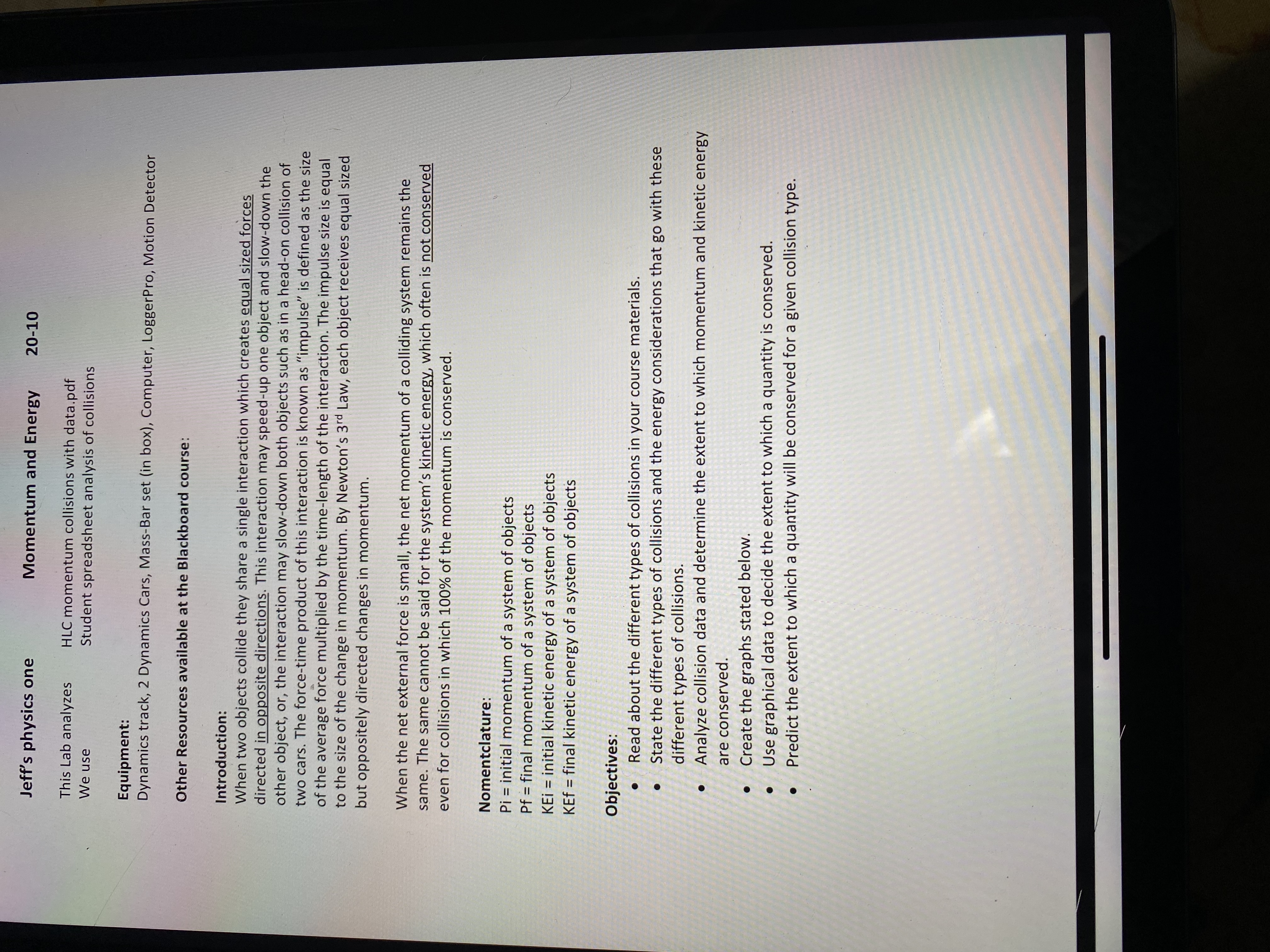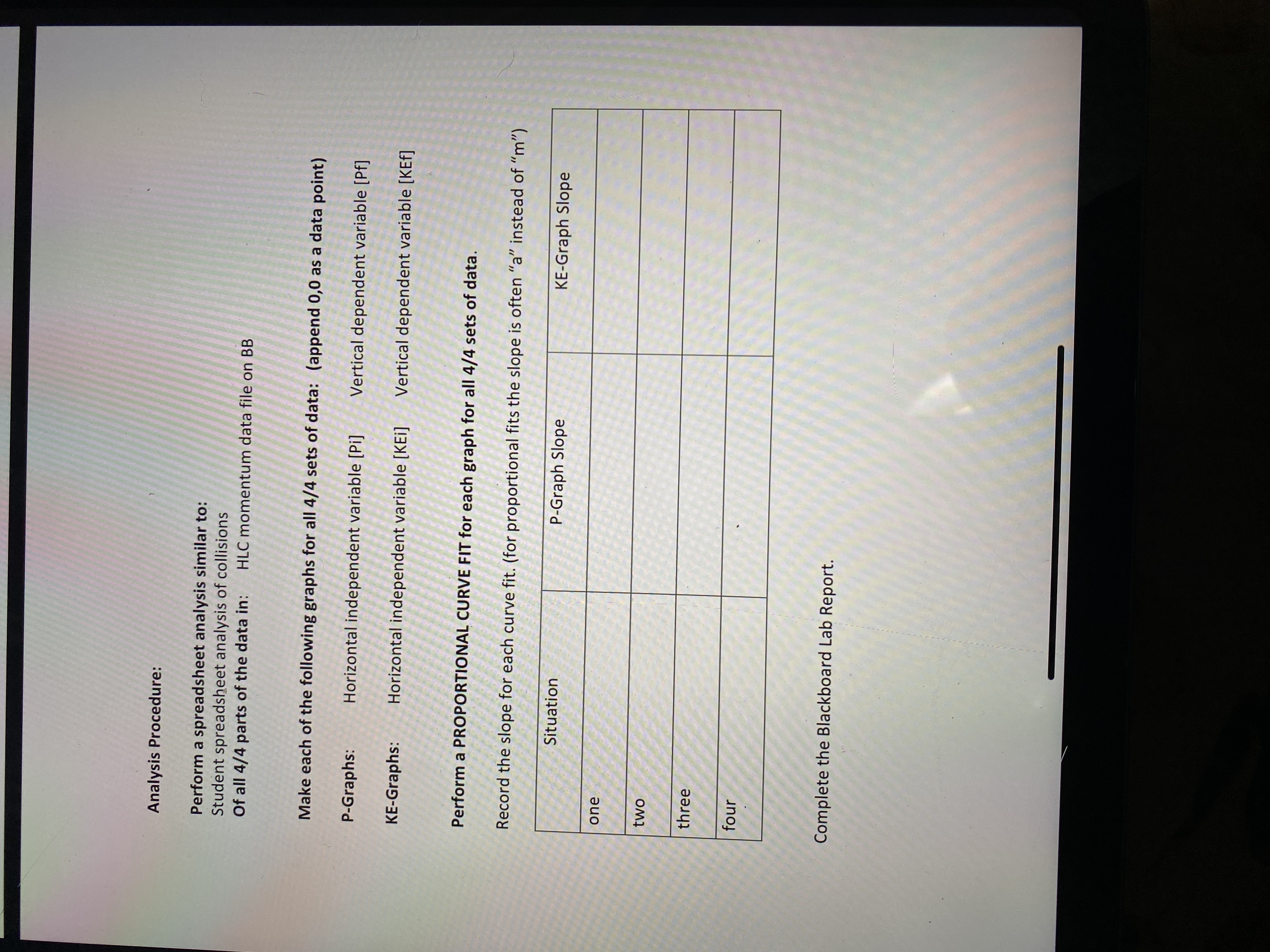Answered step by step
Verified Expert Solution
Question
1 Approved Answer
Need help finish this table and two others Jeff's physics one Momentum and Energy 20-10 This Lab analyzes HLC momentum collisions with data.pdf We use
Need help finish this table and two others

 Jeff's physics one Momentum and Energy 20-10 This Lab analyzes HLC momentum collisions with data.pdf We use Student spreadsheet analysis of collisions Equipment: Dynamics track, 2 Dynamics Cars, Mass-Bar set (in box), Computer, LoggerPro, Motion Detector Other Resources available at the Blackboard course: Introduction: When two objects collide they share a single interaction which creates equal sized forces directed in opposite directions. This interaction may speed-up one object and slow-down the other object, or, the interaction may slow-down both objects such as in a head-on collision of two cars. The force-time product of this interaction is known as "impulse" is defined as the size of the average force multiplied by the time-length of the interaction. The impulse size is equal to the size of the change in momentum. By Newton's 3d Law, each object receives equal sized but oppositely directed changes in momentum. When the net external force is small, the net momentum of a colliding system remains the same. The same cannot be said for the system's kinetic energy, which often is not conserved even for collisions in which 100% of the momentum is conserved. Nomentclature: Pi = initial momentum of a system of objects Pf = final momentum of a system of objects KEi = initial kinetic energy of a system of objects KEf = final kinetic energy of a system of objects Objectives: Read about the different types of collisions in your course materials. . State the different types of collisions and the energy considerations that go with these different types of collisions. Analyze collision data and determine the extent to which momentum and kinetic energy are conserved. Create the graphs stated below. . Use graphical data to decide the extent to which a quantity is conserved. Predict the extent to which a quantity will be conserved for a given collision type.Analysis Procedure: Perform a spreadsheet analysis similar to: Student spreadsheet analysis of collisions Of all 4/4 parts of the data in: HLC momentum data file on BB Make each of the following graphs for all 4/4 sets of data: (append 0,0 as a data point) P-Graphs: Horizontal independent variable [Pi] Vertical dependent variable [Pf] KE-Graphs: Horizontal independent variable [KEi] Vertical dependent variable [KEf] Perform a PROPORTIONAL CURVE FIT for each graph for all 4/4 sets of data. Record the slope for each curve fit. (for proportional fits the slope is often "a" instead of "m") Situation P-Graph Slope KE-Graph Slope one two three four Complete the Blackboard Lab Report
Jeff's physics one Momentum and Energy 20-10 This Lab analyzes HLC momentum collisions with data.pdf We use Student spreadsheet analysis of collisions Equipment: Dynamics track, 2 Dynamics Cars, Mass-Bar set (in box), Computer, LoggerPro, Motion Detector Other Resources available at the Blackboard course: Introduction: When two objects collide they share a single interaction which creates equal sized forces directed in opposite directions. This interaction may speed-up one object and slow-down the other object, or, the interaction may slow-down both objects such as in a head-on collision of two cars. The force-time product of this interaction is known as "impulse" is defined as the size of the average force multiplied by the time-length of the interaction. The impulse size is equal to the size of the change in momentum. By Newton's 3d Law, each object receives equal sized but oppositely directed changes in momentum. When the net external force is small, the net momentum of a colliding system remains the same. The same cannot be said for the system's kinetic energy, which often is not conserved even for collisions in which 100% of the momentum is conserved. Nomentclature: Pi = initial momentum of a system of objects Pf = final momentum of a system of objects KEi = initial kinetic energy of a system of objects KEf = final kinetic energy of a system of objects Objectives: Read about the different types of collisions in your course materials. . State the different types of collisions and the energy considerations that go with these different types of collisions. Analyze collision data and determine the extent to which momentum and kinetic energy are conserved. Create the graphs stated below. . Use graphical data to decide the extent to which a quantity is conserved. Predict the extent to which a quantity will be conserved for a given collision type.Analysis Procedure: Perform a spreadsheet analysis similar to: Student spreadsheet analysis of collisions Of all 4/4 parts of the data in: HLC momentum data file on BB Make each of the following graphs for all 4/4 sets of data: (append 0,0 as a data point) P-Graphs: Horizontal independent variable [Pi] Vertical dependent variable [Pf] KE-Graphs: Horizontal independent variable [KEi] Vertical dependent variable [KEf] Perform a PROPORTIONAL CURVE FIT for each graph for all 4/4 sets of data. Record the slope for each curve fit. (for proportional fits the slope is often "a" instead of "m") Situation P-Graph Slope KE-Graph Slope one two three four Complete the Blackboard Lab Report Step by Step Solution
There are 3 Steps involved in it
Step: 1

Get Instant Access to Expert-Tailored Solutions
See step-by-step solutions with expert insights and AI powered tools for academic success
Step: 2

Step: 3

Ace Your Homework with AI
Get the answers you need in no time with our AI-driven, step-by-step assistance
Get Started


